Related Research Articles

Dorset is a town in Bennington County, Vermont, United States. The population was 2,133 at the 2020 census. Dorset is famous for being the location of Cephas Kent's Inn, where four meetings of the Convention that signed the Dorset Accords led to the independent Vermont Republic and future statehood. Dorset is the site of America's oldest marble quarry and is the birthplace of Bill W., co-founder of Alcoholics Anonymous. East Dorset is the site of the Wilson House and the Griffith Library. The town is named after the English county of Dorset.

Danby is a town in Rutland County, Vermont, United States. The population was 1,284 at the 2020 census.

Proctor is a town in Rutland County, Vermont, United States. The population was 1,763 at the 2020 census. Proctor is home to the Vermont Marble Museum and Wilson Castle.

Granville is a town on the eastern border of Washington County, New York, United States, abutting Rutland County, Vermont. It is part of the Glens Falls Metropolitan Statistical Area. The town population was 6,215 at the 2020 census.

Manchester is a town in, and one of two shire towns of, Bennington County, Vermont. The population was 4,484 at the 2020 census.

Rutland is a town in Rutland County, Vermont, in the United States. As of the 2020 census, the population was 3,924. The Town of Rutland completely surrounds the City of Rutland, which is incorporated separately from the town. The villages of the town effectively comprise the inner suburbs of the City of Rutland.
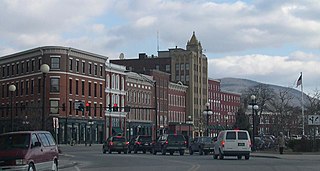
The city of Rutland is the seat of Rutland County, Vermont, United States. As of the 2020 census, the city had a total population of 15,807. It is located approximately 65 miles (105 km) north of the Massachusetts state line, 35 miles (56 km) west of New Hampshire state line, and 20 miles (32 km) east of the New York state line. Rutland is the third largest city in the state of Vermont after Burlington and South Burlington. It is surrounded by the town of Rutland, which is a separate municipality. The downtown area of the city is listed as a historic district on the National Register of Historic Places.

West Rutland is a town in Rutland County, Vermont, United States. The population was 2,214 at the 2020 census. The town center, located in the south-central portion of the town and where about 87% of the population resides, is defined by the U.S. Census Bureau as a census-designated place (CDP). The town is part of the Rutland micropolitan NECTA.

The Taconic Mountains or Taconic Range are a range of the Appalachian Mountains, running along the eastern border of New York State and adjacent New England from northwest Connecticut to western Massachusetts, north to central western Vermont. A physiographic region of the larger New England province, the range includes notable summits, including its high point, 3,840 feet (1,170 m) Mount Equinox in Vermont, and 3,489 feet (1,063 m) Mount Greylock, the highest point in Massachusetts.

Yule Marble is a marble of metamorphosed Leadville Limestone found only in the Yule Creek Valley, in the West Elk Mountains of Colorado, 2.8 miles (4.5 km) southeast of the town of Marble, Colorado. First discovered in 1873, it is quarried underground at an elevation of 9,300 feet (2,800 m) above sea level—in contrast to most marble, which is quarried from an open pit and at much lower elevations.

The Vermont Railway is a shortline railroad in Vermont and eastern New York, operating much of the former Rutland Railway. It is the main part of the Vermont Rail System, which also owns the Green Mountain Railroad, the Rutland's branch to Bellows Falls. The trackage is owned by the Vermont Agency of Transportation except in New York, where VTR operates a line owned by the Boston and Maine Corporation. The rail line employs about 150 people in Vermont.
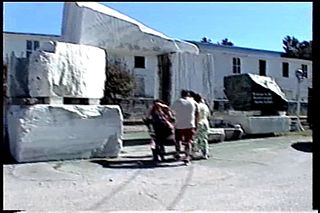
The Vermont Marble Museum or Vermont Marble Exhibit is a museum commemorating the contributions of Vermont marble and the Vermont Marble Company, located in Proctor, Vermont, United States. The museum is located in a wing of one of the former Vermont Marble Company buildings.

Dorset Mountain located in Vermont, on the border of Rutland and Bennington counties, is a mountain of the Taconic Range. The highest summit of Dorset Mountain is within the town of Danby. An unmaintained hiking trail ascends Dorset Peak from the southwest.
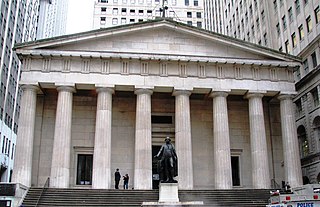
Tuckahoe marble is a type of marble found in southern New York state and western Connecticut. Part of the Inwood Formation of the Manhattan Prong, it dates from the Late Cambrian to the Early Ordovician ages. It was first quarried on a large scale commercially in the village of Tuckahoe, New York. Deposits are also found in the Inwood area of Manhattan, New York City, in Eastchester, New York, and extending southward to parts of the Bronx, such as Kingsbridge, Mott Haven, Melrose and Tremont and Marble Hill. Other locations in Westchester County include Ossining, Hastings, and Thornwood.

The Dorset Village Historic District encompasses a significant portion of the village center of Dorset, Vermont. Centered at the junction of Church Street, Kent Hill Road, and Vermont Route 30, the village was developed between the late 18th and early 20th centuries, and has a number of well-preserved unusual features, including sidewalks of marble from local quarries. The district was listed on the National Register of Historic Places in 1985, and was enlarged to the west in 1997.
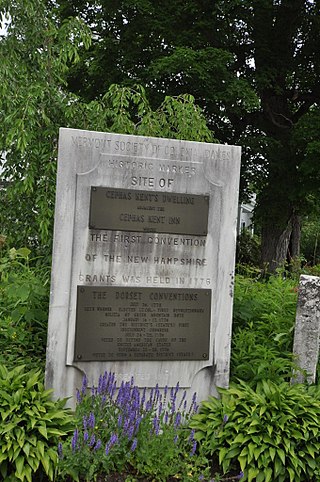
The Kent Neighborhood Historic District encompasses a little-altered early 19th-century rural neighborhood of Dorset, Vermont. Centered at the junction of Dorset West Road and Nichols Hill Road, the area is also historically significant as the site in 1775 of the first meetings that culminated in Vermont's period of independence prior to become the 14th United States state. The district was listed on the National Register of Historic Places in 1978.
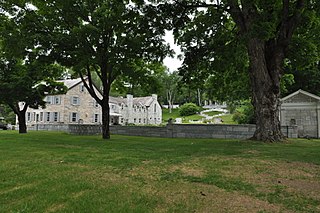
The Manley-Lefevre House is a historic house at 1161 Dorset West Road in Dorset, Vermont. Built out of marble about 1820 and sympathetically enlarged 1908–1927, it is the centerpiece of a 100-acre (40 ha) farm estate that is now home to the Marble House Project, an arts organization offering residencies. The property was added to the National Register of Historic Places in 1990.

The Fair Haven Green Historic District encompasses the village green of Fair Haven, Vermont, and the heterogeneous collection of civic, commercial, and residential buildings that line it and adjacent streets. The area was developed mainly following the arrival of the railroad in 1848 and the subsequent expansion of marble and slate quarries in the area. The district was listed on the National Register of Historic Places in 1980.

The Hardwick and Woodbury Railroad was a short-line railroad serving the towns of Hardwick and Woodbury, Vermont. Built to serve the local granite industry by bringing rough stone from the quarries to the cutting-houses, the railroad was about 7 miles (11 km) long, plus leased track, extended to about 11 miles (18 km) at its greatest extent. It connected with only one other railroad, the St. Johnsbury & Lake Champlain, in Hardwick.

The Woodbury Granite Company (WGC) was a producer of rough and finished granite products. Incorporated in 1887, purchased and significantly reorganized in 1896, and expanded by merger in 1902 and thereafter, the company operated quarries principally in Woodbury, Vermont, but its headquarters and stone-finishing facilities were located in nearby Hardwick. Beginning as a quarrier and seller of rough stone, the company expanded into the business of finishing cut stone and grew from there. It made its name as a supplier of architectural (structural) granite, and grew to become the United States' largest producer, supplying the stone for many notable buildings, including several state capitols, numerous post offices, and many office buildings.
References
- Jones, Robert C., Railroads of Vermont, Volume II, 1993.